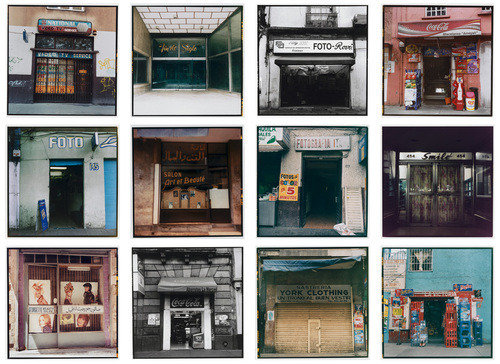Zoe Leonard
dal 26/4/2015 al 29/8/2015
Segnalato da
26/4/2015
Zoe Leonard
The Museum of Modern Art - MoMA, New York
This exhibition presents Zoe Leonard's Analogue, a landmark photographic project conceived over the course of a decade, which documents, in 412 color and black-and-white photographs.

Curated by: Roxana Marcoci, Drew Sawyer, Nancy Newhall
The Museum of Modern Art presents Zoe Leonard: Analogue—a
landmark photographic installation, which was acquired by the Museum in 2013—in the Donald B.
and Catherine C. Marron Atrium from June 27 to August 30, 2015. In 412 color and black-and-
white photographs, Analogue (1998–2009) documents the changing landscape of 20th-century
urban life as seen in vanishing mom-and-pop stores with decaying facades and quirky hand-
written signs and the simultaneous emergence of secondary global markets like the rag trade. Zoe
Leonard: Analogue is organized by Roxana Marcoci, Senior Curator, with Drew Sawyer, Beaumont
and Nancy Newhall Curatorial Fellow, Department of Photography.
Exploring the two-fold tradition of documentary and conceptual photography, Leonard’s
project is positioned within the tradition of the grand visual archives that extend from Eugène
Atget’s Paris and Walker Evans’s America, to Ed Ruscha’s Los Angeles and Martha Rosler’s
Bowery. The artist began photographing shops in her neighborhood on New York’s Lower East
Side in the late 1990s. Over the course of a decade, the project grew to include hundreds of
photographs, displayed in serial grids organized into 25 chapters, that follow the global circulation
of recycled merchandise—used T-shirts, old-fashioned shoes, discarded Coke advertisements, and
old technology like Kodak camera equipment—to far-flung places in Eastern Europe, Africa, Cuba,
and Mexico.
Roxana Marcoci says, “Analogue is an urgent document and poetic allegory of globalization
and the push for technological innovation, revealing the movement of goods and the
homogenization of diverse geographical locations in the 21st century.”
The disappearing storefronts and neglected products are echoed in the obsolete
technology the artist used to reproduce them: a vintage 1940s Rolleiflex camera, along with the
gelatin silver, chromogenic, and dye-transfer printing processes. Leonard underscores the analog
process by not cropping the black frame of the negative from the final 11-by-11” prints, reminding
the viewer of the materiality of celluloid film, a format becoming increasingly obsolete in an age of
digital technology. The embrace of photography as an analog medium is reinforced in the work's
recurrent references to Kodak, photo studios, and graffiti. Analogue is a testament to the loss of
both locally owned shops and straight photography.
To date, Analogue has been presented in various formats since it premiered at the Wexner
Center for the Arts and Documenta 12 in 2007: as a set of 40 dye-transfer prints, as a book, and
as a room-size installation. MoMA is the only institution outside of Europe to own the final
installation, completed in 2009 and presented here for the first time.
ARTIST BIO:
Zoe Leonard was born in 1961 in Liberty, New York, and lives and works in New York. She has
exhibited internationally since the late 1980s and has recently been the subject of solo exhibitions
at Chinati Foundation, Marfa, Texas; Dia:Beacon, New York; Fotomuseum Winterthur,
Switzerland; Museo Nacional Reina Sofia, Madrid; and the Wexner Center for the Arts, Columbus,
Ohio. Her work was included in the 1993, 1997, and 2014 Whitney Biennials and in Documenta 9
(1992) and Documenta 12 (2007).
Image: Zoe Leonard (American, born 1961).
Press Contacts:.
Meg Montgoris, (212) 708-9757, meg_montgoris@moma.org.
Opening: MOnday 27 April.
The Museum of Modern Art,
11 West 53 Street, New York
Hours:
Saturday through Thursday, 10:30 a.m.–5:30 p.m.
Friday, 10:30 a.m.–8:00 p.m.
Museum Admission:
$25 adults; $18 seniors, 65 years and over with I.D



